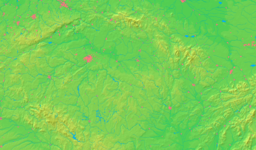- Český Krumlov
-
Český Krumlov Town FlagCoat of armsCountry Czech Republic Region South Bohemian District Český Krumlov Commune Český Krumlov River Vltava Elevation 492 m (1,614 ft) Coordinates 48°48′39.27″N 14°18′54.75″E / 48.8109083°N 14.3152083°E Area 22.16 km2 (8.56 sq mi) Population 14,056 (2007-09-24) Density 634 / km2 (1,642 / sq mi) First mentioned 1253 Mayor Dalibor Carda Timezone CET (UTC+1) - summer (DST) CEST (UTC+2) Postal code 381 01 UNESCO World Heritage Site Name Historic Centre of Český Krumlov Year 1992 (#16) Number 617 Region Europe and North America Criteria iv Wikimedia Commons: Český Krumlov Statistics: statnisprava.cz Website: www.ckrumlov.info Český Krumlov (Czech pronunciation: [ˈtʃɛskiː ˈkrumlof] (
 listen); German: Krummau an der Moldau or Böhmisch Krummau; Krumau variant is used sometimes) is a small city in the South Bohemian Region of the Czech Republic, best known for the fine architecture and art of the historic old town and Český Krumlov Castle. Old Český Krumlov is a UNESCO World Heritage Site and was given this status along with the historic Prague castle district.
listen); German: Krummau an der Moldau or Böhmisch Krummau; Krumau variant is used sometimes) is a small city in the South Bohemian Region of the Czech Republic, best known for the fine architecture and art of the historic old town and Český Krumlov Castle. Old Český Krumlov is a UNESCO World Heritage Site and was given this status along with the historic Prague castle district.The city is named Český Krumlov ("Bohemian Krumlov") to differentiate it from Moravský Krumlov ("Moravian Krumlov") in the southeast of the country.
History
Construction of the town and castle began in the late 13th century at a ford in the Vltava River, which was important in trade routes in Bohemia. In 1302 the town and castle were owned by the House of Rosenberg. Emperor Rudolf II bought Krumlov in 1602 and gave it to his natural son Julius d’Austria. Emperor Ferdinand II gave Krumlov to the House of Eggenberg. From 1719 until 1945 the castle belonged to the House of Schwarzenberg. Most of the architecture of the old town and castle dates from the 14th through 17th centuries; the town's structures are mostly in Gothic, Renaissance, and Baroque styles. The core of the old town is within a horseshoe bend of the river, with the old Latrán neighborhood and castle on the other side of the Vltava.
The town was seat of Duchy of Krumlov. 8,662 inhabitants lived in Krumau an der Moldau in 1910, including 7,367 Germans and 1,295 Czechs.
During the interwar era it was part of Czechoslovakia. Between 1938 and 1945 it was annexed by Nazi Germany as part of the so-called Sudetenland. The town's German-speaking population was expelled after liberation by the American Army during World War II and it was restored to Czechoslovakia.[1]
During the Communist era of Czechoslovakia, Krumlov fell into disrepair, but since the Velvet Revolution of 1989 much of the town's former beauty has been restored, and it is now a major holiday destination popular with tourists from Germany, Austria, and beyond. In August, 2002, the town suffered from damage in the great flood of the Vltava River.
Sights
Castle
Český Krumlov Castle is unusually large for a town of Krumlov's size; within the Czech Republic it is second in extent only to the Hradčany castle complex of Prague. Inside its grounds are a large garden, an extensive bridge over a deep gap in the rock upon which the castle is built, and the castle itself, which in turn consists of many defined parts dating from different periods of time. After the garden was not adequately maintained during the second half of the 20th century, the site was included in the 1996 World Monuments Watch by the World Monuments Fund. With financial support from American Express the garden's central fountain was documented and reconstructed, and is functional today.[2]
Church of St. Vitus (Kostel Sv. Víta) is a Gothic church dating back to the 15th century with frescoes from the same period.
Castle Theatre
Český Krumlov Castle preserves its Baroque theatre, built from 1680-82 under Prince Johann Christian I von Eggenberg and renovated with modern (at the time) stage equipment under Josef Adam zu Schwarzenberg from 1765-66. With this original stage machinery, scenery and props it is among only a few such court theatres that still exist[3] Due to its age, the theatre is only used three times a year (only two are open to the public), when a Baroque opera is performed in simulated candlelight. The castle's last private owner was Adolph Schwarzenberg. It was here that he received President Edvard Beneš and gave him a large contribution for the defence of Czechoslovakia against the growing threat of Nazi Germany. His property was seized by the Gestapo in 1940 and then confiscated by the Czechoslovak government in 1945.
Nearby
Krumlov has a museum dedicated to the painter Egon Schiele, who lived in the town.
Ten kilometers from Krumlov is one of Bohemia's oldest monasteries, Zlatá Koruna ("The Golden Crown"). About 30 km from Krumlov is the Hluboka Castle, established in the twelfth century and later remodelled in imitation of Windsor Castle.
Krumlov is close to the Šumava National Park, the Czech Republic's largest national park. The Šumava mountains lie along the border with Austria and Germany and offer a range of natural habitats - peat bogs, Alpine meadows, old-growth forests, lakes, and rivers. The area is popular with walkers, cyclists, and canoeists on the Vltava. Cesky Krumlov is only a short distance from the man-made Lake Lipno, on which many people take boat trips to various small towns on the lake and also to the Dam, which is a Hydro-electric power plant.
Český Krumlov is home to Pivovar Eggenberg brewery. It has also been used as filming locations for movies such as the 2006 films The Illusionist and Hostel as well as the 1970s German movie Traumstadt (Dream City).
Culture
Český Krumlov is an important cultural center, hosting a number of festivals and other events each year. The best known is the Five-Petalled Rose Festival (the name is derived from the Rožmberk crest of a 5 petal red rose), which is celebrated on the weekend of summer solstice in June. The downtown area is recreated as a medieval town with craftsmen, artists, musicians, and local people dressed in costumes from the Middle Ages. Various activities such as jousting, fencing, historical dance performances, and folk theatre take place at the castle, local park, and the river bank, among other places. The festival is concluded by a fireworks show above the castle.
The International Music Festival Cesky Krumlov is one of the summer's cultural events. The Festival begins in July and ends in August, and features International music from varied musical genres.[4] In addition, various other festivals are sprouting up throughout the year. Summer music festivals in Cesky Krumlov also include the latest blues, rock, and soul festival Open Air Krumlov, which is held annually in late June at Eggenberg Brewery Garden in Cesky Krumlov.
Since the Velvet Revolution in 1989, over eighty restaurants have been established in the area. Many restaurants are located along the river and near the castle.
People
See also Category: People from Český Krumlov.- House of Rosenberg (Czech: Rožmberk(ové), sg. z Rožmberka), since about 1250
- House of Eggenberg (since 1622 until 1717)
- Stephan Krumenauer (1400–1461), master builder, acted in Germany (de)
- Jakub Horčický z Tepence (1575–1622), physician, chemist (de)
- Anton Hickel (1745–1798), painter
- Joseph Karl Ambrosch (1759–1822), tenor singer, composer (de)
- Prince Felix of Schwarzenberg (1800–1852, Vienna), Austrian statesman
- Marie Soukup(ová), mother of Egon
- Egon Schiele (1890–1918), Austrian painter, lived here; There is the Egon Schiele Art Centrum
- Karel Šmirous (1890–1981, Prague), Czech scientist
- Ernst Waldbrunn (1907–1977), Austrian actor, Kabarettist (de)
- Anna Chromy (born 1940), painter and sculptor
- Dana Kuchtová (born 1961), Czech politician
- Tomáš Kobes (born 1978), Czech slalom canoer
- Residents
- Jaroš Griemiller (acted 16th century, Třebsko), worked here
- Šimon Lomnický z Budče (1552–1622), Czech writer (de)
- Wenzel Albin von Helfenburg (~1500 - 1577), archivist (de)
- Petr Eben (1929, Žamberk - 2007), Czech composer
- Marek Kopelent (born 1932, Prague), lecturer of the "International Composers' Summer Courses" in this city
See also
- The House of Rožmberk – history of the Rosenbergs (Rožmberks) noble family of Southern Bohemia and Lords of Krumlov and Rožmberk
- The House of Eggenberg - history of the Eggenbergs, a noble family from Styria, Austria and Dukes of Krumau during the Baroque Era
Gallery
References
- ^ History of the town of Český Krumlov
- ^ World Monuments Fund - Český Krumlov Garden
- ^ There are others at Drottningholm and Gripsholm in Sweden.
- ^ [1]
External links
- Official site
- Český Krumlov's Common Licensed Photos
- Ckrumlov.cz, town history (Czech)
- Official pages of the State Castle Český Krumlov
- State Castle Český Krumlov
- Museum on the local passion play and other items
- International Music Festival Český Krumlov
- Shuttle bus transportation
World Heritage Sites in the Czech Republic Český Krumlov · Gardens and Castle at Kroměříž · Holašovice Historical Village Reservation · Holy Trinity Column in Olomouc · Jewish Quarter and St. Procopius' Basilica, Třebíč · Kutná Hora · Lednice–Valtice Cultural Landscape · Litomyšl Castle · Pilgrimage Church of Saint John of Nepomuk · Prague · Telč · Tugendhat Villa, Brno
Categories:- World Heritage Sites in the Czech Republic
- Český Krumlov
- Český Krumlov District
- Cities and towns in the Czech Republic
- Castles in the Czech Republic
Wikimedia Foundation. 2010.



















